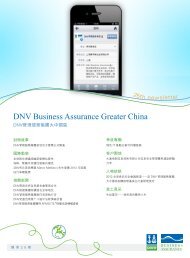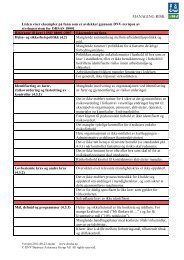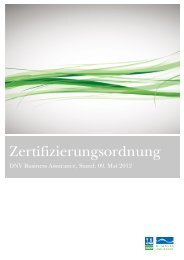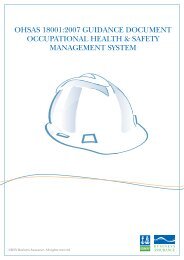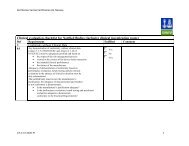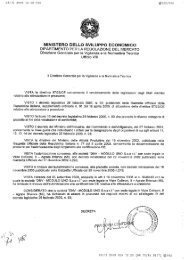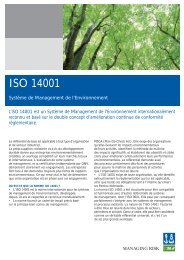10 STEPS TO ISO 14001 CERTIFICATION - DNV
10 STEPS TO ISO 14001 CERTIFICATION - DNV
10 STEPS TO ISO 14001 CERTIFICATION - DNV
Create successful ePaper yourself
Turn your PDF publications into a flip-book with our unique Google optimized e-Paper software.
<strong>10</strong> <strong>STEPS</strong> <strong>TO</strong><br />
<strong>ISO</strong> <strong>14001</strong><br />
<strong>CERTIFICATION</strong><br />
Implementing an environmental management system (EMS) can<br />
help you manage environmental risks, provide assurances in legal<br />
compliance and demonstrate your environmental credentials to<br />
your stakeholders.<br />
<strong>DNV</strong> offers <strong>10</strong> simple steps to certification:<br />
1. Identify your drivers<br />
It is recommended you identify and review your key drivers<br />
for implementing an EMS and the goals that you want to<br />
achieve from embarking on the journey. Remember that<br />
a key requirement is to ensure continual improvement of<br />
environmental performance.<br />
2. Access your resources and define your strategy<br />
Do you have a budget for implementing the EMS and the key<br />
competencies available within your business?<br />
It is important to remember that effective implementation<br />
will require commitment throughout and should not be<br />
seen as one person’s responsibility. Commitment starts<br />
with senior management and they should decide the<br />
implementation strategy and timelines. An implementation<br />
plan should be developed and a dedicated team assigned.<br />
3. Dialogue with your certification body<br />
An early dialogue with your preferred certification body can<br />
help to dismiss some of the myths surrounding <strong>ISO</strong> <strong>14001</strong>.<br />
Whilst direct consultancy is not permitted, general guidance<br />
and the approach to certification can be discussed.<br />
4. Gap analysis?<br />
A useful first step could be to undertake a gap analysis<br />
between the management system processes you currently<br />
have in place and the requirements of <strong>ISO</strong> <strong>14001</strong>.<br />
As many companies currently have some form of<br />
management system in place and as <strong>14001</strong> requires a<br />
firm understanding and commitment to comply with legal<br />
requirements there could some already existent processes<br />
in place. A gap analysis could be conducted in house or<br />
using external resources.<br />
5. System integration?<br />
At an early stage it is recommended that you review<br />
whether or not to integrate your EMS with other systems.<br />
The advantage is that this can minimise the number of<br />
procedures required and therefore cause less confusion;<br />
but there is a risk that integration can dilute the impact<br />
of a system (e.g. production or health and safety related<br />
processes over-riding environmental considerations and<br />
focus). One recommendation, however, is that duplication<br />
within management systems is avoided.<br />
6. Develop your EMS - what are your impacts?<br />
It is recommended that you tailor your EMS to your<br />
business. A good place to start is the identification of<br />
environmental aspects and impacts.<br />
There are various approaches that can be used and matters<br />
that are often overlooked include the use of natural<br />
resources such as energy and water, and past activities<br />
with reference to the potential for contaminated land.
So-called “indirect impacts” such as the practices of<br />
suppliers and the use of final products/services are<br />
frequently not addressed. You should also ensure that you<br />
have a logical process for determining the significance or<br />
importance of your significant environmental impacts - your<br />
EMS should be managing your significant impacts.<br />
From here, the remainder of the EMS should be logical (e.g.<br />
your Environmental Policy reflects your business, there is<br />
a logical description of the EMS and easy navigation, any<br />
documented procedures reflect key environmental impacts<br />
and legal requirements, you monitor and measure your key<br />
environmental impacts etc.).<br />
7. Identify your legal and other requirements<br />
Most organisations use some form of register to compile<br />
regulatory and other policy requirements. An important<br />
preparatory step is to consider the information sources to<br />
be used.<br />
Auditors also seek your understanding of environmental<br />
law in order to demonstrate that you have been able to<br />
clearly determine whether it applies to you and how it<br />
applies to you. It is also worth considering some formal<br />
mechanism for reviewing and up-dating the legislation and<br />
for communicating the main provisions, as they apply, to<br />
those that need to know. Be mindful of the fact that your<br />
EMS auditors will review compliance with legal conditions<br />
(in Permits etc.).<br />
8. Complete your EMS development<br />
Once you have a good understanding of where your<br />
business impacts the environment and its legal<br />
requirements it will be possible to define some pertinent<br />
environmental objectives and targets - with supporting<br />
programmes defining who, when and how the objects and<br />
targets will be achieved.<br />
Be mindful that in the early stages of an EMS that it is<br />
possible to set investigations as targets (e.g. the business is<br />
unsure of its energy profile, and so the first step will be to<br />
obtain sound data - on which it will then be possible to set<br />
quantified targets). A sound foundation of understanding<br />
environmental impacts, legal requirements topped with<br />
a set of objectives that and targets that will results in<br />
continual improvement are the cornerstone of an EMS.<br />
9. Implement your EMS<br />
In reality implementation commences as soon as you have<br />
the commitment, but remember implementation is not one<br />
persons’ responsibility.<br />
There will also be a need to ensure that everyone in<br />
the business receives some training and awareness - at<br />
least covering the basics of the EMS, where to find key<br />
information, the Environmental Policy, objective and targets<br />
and ideally key environmental impacts. The degree of this<br />
training and awareness will be dependent on the level of<br />
complexity and involvement of the target audience. A<br />
key and overlooked part of the implementation process is<br />
to ensure that you commence the internal audit process,<br />
which must be fully operational and effective before<br />
certification can be granted.<br />
Be mindful also that <strong>ISO</strong> <strong>14001</strong> requires “evaluations of<br />
compliance with legal and other requirements” and that<br />
most organisations use their internal audits to address<br />
this requirement. After a period of implementation, a<br />
management review should be conducted to review the<br />
current state of the EMS implementation and whether it is<br />
delivering its goals.<br />
<strong>10</strong>. Go for certification<br />
If you are conducting effective internal audits, they will<br />
give you a clear indication as to whether your business is<br />
ready for certification. Be aware that most certification<br />
bodies work on fairly long lead times and that a first time<br />
certification is a two-staged process; so forward planning<br />
and early dialogue is key.




